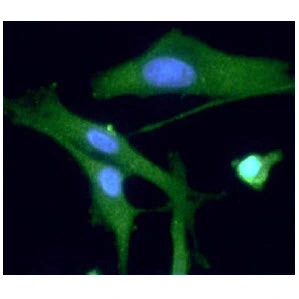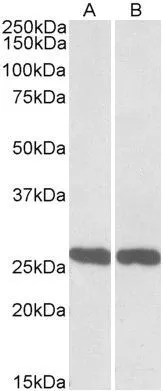PGP9.5 antibody
GTX109637
ApplicationsImmunoFluorescence, Western Blot, ImmunoCytoChemistry, ImmunoHistoChemistry, ImmunoHistoChemistry Frozen, ImmunoHistoChemistry Paraffin
Product group Antibodies
TargetUCHL1
Overview
- SupplierGeneTex
- Product NamePGP9.5 antibody
- Delivery Days Customer9
- Application Supplier NoteWB: 1:1000-1:20000. ICC/IF: 1:100-1:1000. IHC-P: 1:100-1:1000. IHC-Fr: 1:100-1:1000. *Optimal dilutions/concentrations should be determined by the researcher.Not tested in other applications.
- ApplicationsImmunoFluorescence, Western Blot, ImmunoCytoChemistry, ImmunoHistoChemistry, ImmunoHistoChemistry Frozen, ImmunoHistoChemistry Paraffin
- CertificationResearch Use Only
- ClonalityPolyclonal
- Concentration1.79 mg/ml
- ConjugateUnconjugated
- Gene ID7345
- Target nameUCHL1
- Target descriptionubiquitin C-terminal hydrolase L1
- Target synonymsHEL-117, HEL-S-53, NDGOA, PARK5, PGP 9.5, PGP9.5, PGP95, SPG79, SPG79A, UCHL-1, Uch-L1, ubiquitin carboxyl-terminal hydrolase isozyme L1, epididymis luminal protein 117, epididymis secretory protein Li 53, neuron cytoplasmic protein 9.5, ubiquitin carboxyl-terminal esterase L1 (ubiquitin thiolesterase), ubiquitin thioesterase L1, ubiquitin thiolesterase
- HostRabbit
- IsotypeIgG
- Protein IDP09936
- Protein NameUbiquitin carboxyl-terminal hydrolase isozyme L1
- Scientific DescriptionUCHL1 is a member of a gene family whose products hydrolyze small C-terminal adducts of ubiquitin to generate the ubiquitin monomer. Expression of UCHL1 is highly specific to neurons and to cells of the diffuse neuroendocrine system and their tumors. It is present in all neurons (Doran et al., 1983 [PubMed 6343558]).[supplied by OMIM]
- Storage Instruction-20°C or -80°C,2°C to 8°C
- UNSPSC12352203
References
- Clayton DR, Ruiz WG, Dalghi MG, et al. Studies of ultrastructure, gene expression, and marker analysis reveal that mouse bladder PDGFRA(+) interstitial cells are fibroblasts. Am J Physiol Renal Physiol. 2022,323(3):F299-F321. doi: 10.1152/ajprenal.00135.2022Read this paper
- Chang WY, Yang YT, She MP, et al. 5-HT(7) receptor-dependent intestinal neurite outgrowth contributes to visceral hypersensitivity in irritable bowel syndrome. Lab Invest. 2022,102(9):1023-1037. doi: 10.1038/s41374-022-00800-zRead this paper
- Fede C, Petrelli L, Guidolin D, et al. Evidence of a new hidden neural network into deep fasciae. Sci Rep. 2021,11(1):12623. doi: 10.1038/s41598-021-92194-zRead this paper
- Koshimizu H, Ohkawara B, Nakashima H, et al. Zonisamide ameliorates neuropathic pain partly by suppressing microglial activation in the spinal cord in a mouse model. Life Sci. 2020,263:118577. doi: 10.1016/j.lfs.2020.118577Read this paper
- Xu YM, Tan HW, Zheng W, et al. Cadmium telluride quantum dot-exposed human bronchial epithelial cells: a further study of the cellular response by proteomics. Toxicol Res (Camb). 2019,8(6):994-1001. doi: 10.1039/c9tx00126cRead this paper
- Hong J, Lisco AM, Rudebush TL, et al. Identification of Cardiac Expression Pattern of Transient Receptor Potential Vanilloid Type 1 (TRPV1) Receptor using a Transgenic Reporter Mouse Model. Neurosci Lett. 2020,737:135320. doi: 10.1016/j.neulet.2020.135320Read this paper
- Canta A, Chiorazzi A, Pozzi E, et al. Calmangafodipir Reduces Sensory Alterations and Prevents Intraepidermal Nerve Fibers Loss in a Mouse Model of Oxaliplatin Induced Peripheral Neurotoxicity. Antioxidants (Basel). 2020,9(7). doi: 10.3390/antiox9070594Read this paper
- Dragunas G, Woest ME, Nijboer S, et al. Cholinergic neuroplasticity in asthma driven by TrkB signaling. FASEB J. 2020,34(6):7703-7717. doi: 10.1096/fj.202000170RRead this paper
- Pagella P, Catón J, Meisel CT, et al. Ameloblastomas Exhibit Stem Cell Potential, Possess Neurotrophic Properties, and Establish Connections with Trigeminal Neurons. Cells. 2020,9(3). doi: 10.3390/cells9030644Read this paper
- Alberti P, Canta A, Chiorazzi A, et al. Topiramate prevents oxaliplatin-related axonal hyperexcitability and oxaliplatin induced peripheral neurotoxicity. Neuropharmacology. 2020,164:107905. doi: 10.1016/j.neuropharm.2019.107905Read this paper






![Western blot of rat hippocampal homogenate showing specific immunolabeling of the ~ 24k UCHL1 protein using UCHL1 antibody [BH7] (GTX82568)](https://www.genetex.com/upload/website/prouct_img/normal/GTX82568/UCHL1-antibody-BH7__GTX82568-1_w_23061322_428.webp)